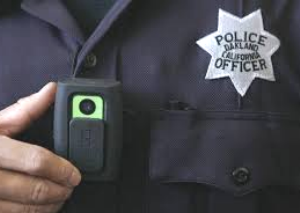
Amid accusations of excessive force and increasing civilian video of police activity, New York officers may wear cameras while on duty. Had the death of 43-year-old Eric Garner not been caught on film, calls to outfit New York Police Department officers with cameras might have quietly faded. Instead, a bystander captured Garner locked in a chokehold as he repeated: “I can’t breathe.”
Garner’s encounter with police – ruled a homicide by the New York city medical examiner – is not the only one that has resulted in visceral video. A driver captured a California highway patrol officer punching a woman repeatedly as she shielded her face with her arms. Two weeks after the video of Garner went viral, building residents filmed the NYPD dragging a Brooklyn grandmother out of her apartment in her underwear.
On Monday, the public advocate of New York, Letitia James, called on the city’s police department, once again, to begin a pilot program using the cameras. “We need action today,” she told a news conference. The NYPD, America’s most influential police department, confirmed that it is reconsidering the potential of such cameras.
Even as departments face scrutiny because of citizens’ videos, they are being pressed to adopt the technology themselves. Attempts to hold police accountable with video are not new, and neither is law enforcement’s distaste for being filmed. But the long history of avoiding the lens is bumping up against technology, as strapping cameras to officers themselves is increasingly considered good policing practice.
“We’re at the very beginning of something that could be very, very big,” said Sydney Siegmeth, spokesman for Taser International. The company produces the now-standard weapon that delivers a stunning electric shock, and recently waded into the body-worn camera market with the Axon. “I think more and more you’re going to see officers with technology on their body,” she said.
The company’s camera sales shot up by more than five times over the past year. Contracts increased to nearly 5,000 cameras and $11.3m in sales last quarter. More than 1,200 law enforcement officers now wear the cameras. The company regards all of the 18,000 police departments in the United States as a potential market for the technology – as well as private security guards, corrections officers, police forces outside the US and even municipal employees.
Civil libertarians have already signed off on police-worn camera programs, making it one of the few circumstances in which the organizations are calling for more, not less, surveillance.
“It serves more as a form of checks and balances against police power than it does for the government [control] over individuals,” said Jay Stanley, senior policy analyst at the American Civil Liberties Union.
“There needs to be very strong [privacy] protection, but at the same time we also see large numbers of very abusive Swat raids,” he said. “So it’s vital to have [cameras]”.
The most cited study of the effects of body-worn cameras on policing is Cambridge University’s examination of the police department in Rialto, California. After cameras were introduced in February 2012, officers’ use of force dropped 59%, and complaints against officers plummeted by 88%.
“It would be a nightmare,” former New York City mayor Michael Bloomberg told the press after a ruling on the city’s “stop-and-frisk” laws, almost exactly one year ago, in which judge Shira Scheindlin ordered that the department start a one-year pilot using the cameras in five precincts.
See previous court ruling on NYPD body-worm camera requirement.
“We can’t have your cameraman follow you around and film things without people questioning whether they deliberately chose an angle, whether they got the whole picture in.”
Rialto police captain Randy De Anda said the NYPD sent two senior officials to his department in the last two weeks. Perhaps it shouldn’t be a surprise the officers went to California – New York police commissioner Bill Bratton’s last position was in Los Angeles, and he has voiced his support for the cameras in the past.
“They’re really seriously thinking about it,” said De Anda. A spokesperson for the NYPD said the department is “exploring and evaluating the technology”.
James said on Monday it would cost the NYPD about $5m to outfit 15% of the force’s 23,000 patrol officers. Her analysis didn’t address the cost of processing the vast amount of data the cameras generate. By contrast, she said, last year the department paid out $152m to settle complaints brought against it.
Source: theguardian.com
